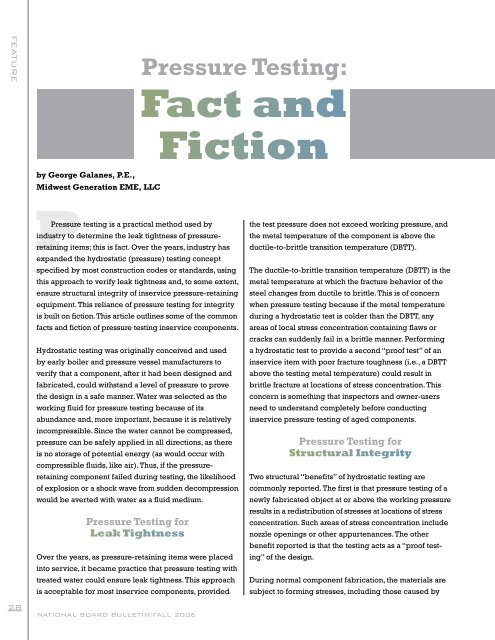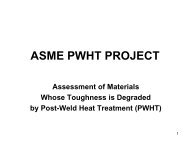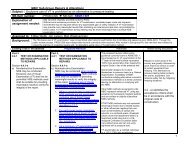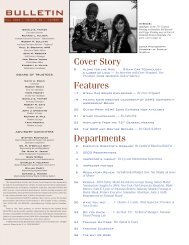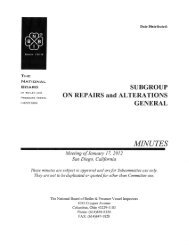bulletin - The National Board of Boiler and Pressure Vessel Inspectors
bulletin - The National Board of Boiler and Pressure Vessel Inspectors
bulletin - The National Board of Boiler and Pressure Vessel Inspectors
You also want an ePaper? Increase the reach of your titles
YUMPU automatically turns print PDFs into web optimized ePapers that Google loves.
FEATURE<br />
28<br />
by George Galanes, P.E.,<br />
Midwest Generation EME, LLC<br />
P<strong>Pressure</strong> testing is a practical method used by<br />
industry to determine the leak tightness <strong>of</strong> pressureretaining<br />
items; this is fact. Over the years, industry has<br />
exp<strong>and</strong>ed the hydrostatic (pressure) testing concept<br />
specified by most construction codes or st<strong>and</strong>ards, using<br />
this approach to verify leak tightness <strong>and</strong>, to some extent,<br />
ensure structural integrity <strong>of</strong> inservice pressure-retaining<br />
equipment. This reliance <strong>of</strong> pressure testing for integrity<br />
is built on fiction.This article outlines some <strong>of</strong> the common<br />
facts <strong>and</strong> fiction <strong>of</strong> pressure testing inservice components.<br />
Hydrostatic testing was originally conceived <strong>and</strong> used<br />
by early boiler <strong>and</strong> pressure vessel manufacturers to<br />
verify that a component, after it had been designed <strong>and</strong><br />
fabricated, could withst<strong>and</strong> a level <strong>of</strong> pressure to prove<br />
the design in a safe manner.Water was selected as the<br />
working fluid for pressure testing because <strong>of</strong> its<br />
abundance <strong>and</strong>, more important, because it is relatively<br />
incompressible. Since the water cannot be compressed,<br />
pressure can be safely applied in all directions, as there<br />
is no storage <strong>of</strong> potential energy (as would occur with<br />
compressible fluids, like air). Thus, if the pressureretaining<br />
component failed during testing, the likelihood<br />
<strong>of</strong> explosion or a shock wave from sudden decompression<br />
would be averted with water as a fluid medium.<br />
<strong>Pressure</strong> Testing for<br />
Leak Tightness<br />
Over the years, as pressure-retaining items were placed<br />
into service, it became practice that pressure testing with<br />
treated water could ensure leak tightness. This approach<br />
is acceptable for most inservice components, provided<br />
NATIONAl BOARD BUllETIN/FAll 2006<br />
<strong>Pressure</strong> Testing:<br />
Fact <strong>and</strong><br />
Fiction<br />
the test pressure does not exceed working pressure, <strong>and</strong><br />
the metal temperature <strong>of</strong> the component is above the<br />
ductile-to-brittle transition temperature (DBTT).<br />
<strong>The</strong> ductile-to-brittle transition temperature (DBTT) is the<br />
metal temperature at which the fracture behavior <strong>of</strong> the<br />
steel changes from ductile to brittle. This is <strong>of</strong> concern<br />
when pressure testing because if the metal temperature<br />
during a hydrostatic test is colder than the DBTT, any<br />
areas <strong>of</strong> local stress concentration containing flaws or<br />
cracks can suddenly fail in a brittle manner. Performing<br />
a hydrostatic test to provide a second “pro<strong>of</strong> test” <strong>of</strong> an<br />
inservice item with poor fracture toughness (i.e., a DBTT<br />
above the testing metal temperature) could result in<br />
brittle fracture at locations <strong>of</strong> stress concentration. This<br />
concern is something that inspectors <strong>and</strong> owner-users<br />
need to underst<strong>and</strong> completely before conducting<br />
inservice pressure testing <strong>of</strong> aged components.<br />
<strong>Pressure</strong> Testing for<br />
Structural Integrity<br />
Two structural “benefits” <strong>of</strong> hydrostatic testing are<br />
commonly reported. <strong>The</strong> first is that pressure testing <strong>of</strong> a<br />
newly fabricated object at or above the working pressure<br />
results in a redistribution <strong>of</strong> stresses at locations <strong>of</strong> stress<br />
concentration. Such areas <strong>of</strong> stress concentration include<br />
nozzle openings or other appurtenances. <strong>The</strong> other<br />
benefit reported is that the testing acts as a “pro<strong>of</strong> testing”<br />
<strong>of</strong> the design.<br />
During normal component fabrication, the materials are<br />
subject to forming stresses, including those caused by


